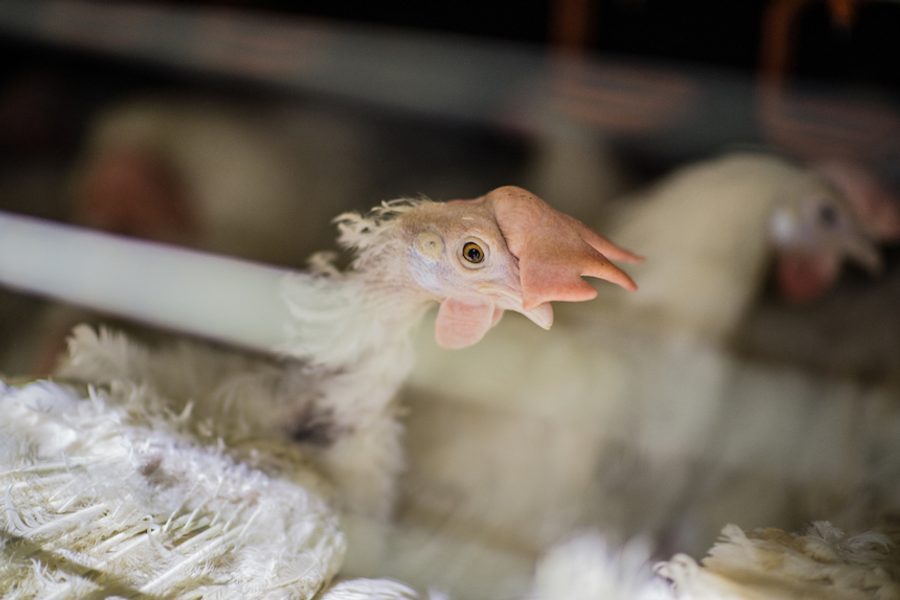
Next Tuesday, sandwiched between ballot measures on charter schools and marijuana, Massachusetts voters will decide whether or not to pass one of the more progressive animal welfare measures in the country.
“Question 3,” endorsed by the Humane Society of the United States (HSUS), the Humane League, Mercy for Animals and a bevy of other animal welfare organizations, would prevent the sale and production of pork, veal and eggs coming from farms where “animals are confined in a cruel manner,” where “cruel” is defined as “prevent[ing] a[n] animal from lying down, standing up, fully extending the animal’s limbs or turning around freely.”
Polls suggest it will pass easily, and similar legislation in California — Prop 2, which food writer Mark Bittman called “the most significant animal welfare law in recent history” — passed with nearly two-thirds of the vote in 2008. Indeed, it’s not just vegans who care about our sentient cousins: According to a 2015 Gallup poll, 94 percent of Americans say nonhuman animals deserve at least “some protection from harm and exploitation.”
But while I’d still vote yes on Question 3, and have nothing but respect for the hard work and good intentions of the activists behind it, its definition of “cruel” sets such a low bar that the main suffering it’s likely to alleviate is that of the eater’s conscience. The idea of an animal living a happy and healthy life ending in a swift, painless death — as opposed to the cramped, unsanitary hellholes of too many farms — is for the most part just that: an idea, and one with little relation to what’s in your supermarket.
Despite cheerleading from even ostensibly anti-meat groups, the welfare gains promised by Prop 2, cage-free initiatives and other reforms are largely smoke-and-mirrors. The good will of the public — at least those who can afford to shop at Whole Foods or fork over extra cash for cage-free eggs — is being exploited financially with little to no actual improvement in animal wellbeing. Advocacy groups like PETA and Direct Action Everywhere (DxE) are now suggesting that the whole so-called humane industry is a sham.
The reforms so eagerly championed — HSUS put millions of dollars into its Prop 2 campaign, and supporters of Question 3 have raised over $1 million — are not working. And they’ll never work unless we move towards a more plant-based food system.
The myth of animal welfare
FOIA requests filed by DxE found no record of enforcement action on Prop 2, despite several California egg farms still not meeting the newly mandated space requirements. (Some of them still don’t meet the old requirements.) At a “humane certified” egg farm that supplies Costco, Trader Joe’s and Safeway, members of the group filmed widespread sickness, injury, death and overcrowding.
One comprehensive study showed that cage-free egg operations — to which many companies are moving, in part due to pressure from HSUS and other animal advocates — have higher mortality rates than the caged ones they’re replacing, due to crowded, filthy conditions that contribute to cannibalism and poor air quality. Some animal rights groups maintain cage-free eggs are still better than the alternative; I’ve been informally involved with groups on both sides of the divide, but as I cannot directly ask a hen which they prefer, I’ll remain agnostic. But “cage-free” clearly doesn’t meet the cruelty-free standards many consumers have in mind.
Corporations like Whole Foods (WF) aggressively advertise their strict “humane” standards and sell “compassionate” products for which consumers eagerly pay more. In 2005 PETA, HSUS and other animal advocates signed a letter of appreciation for WF’s rigorous welfare policies. Even the vegans were impressed!
But the honeymoon’s over: Recent investigations into pig, turkey and egg farms show that WF’s standards don’t look as humane in practice as they do on paper. PETA, for example, found pigs packed tightly into concrete sheds, in violation of WF policy. Several had “grotesque rectal prolapses” or other untreated ailments. PETA sued the company for consumer fraud, and this year PETA, DxE and other advocacy organizations wrote a new letter asking WF to end its “fraudulent ‘animal welfare’ marketing and [its] financial support for violence against animals.”
Insofar as some welfare standards exist, we should at least call for better enforcement of what’s already on the books. But for the most part, such campaigns spend considerable time and energy on costly, logistically difficult transitions to what are at best slight improvements on the status quo and, arguably, simply a different form of torture. If you outlaw one form of abuse, food corporations — fueled by the need to make a profit — will come up with another.
Plus, after all these failures, it’s tough to get excited about a slightly bigger cage. Such minor reforms do nothing to address the more quotidian injustices of life on the farm: the one-day-old calf separated from his mother so we can take all her milk; the piglet castrated with no pain relief; the chicken so fat from generations of selective breeding she can’t support her own weight. Contemporary animal agriculture does not need tinkering at the margins — it is rotten to the core.
The way forward
A key problem undergirding this whole fiasco is the sheer quantity of animal products consumed by industrialized nations, especially the United States, which environmentalists, public health advocates and animal protectionists all recognize needs to decrease. There is simply not enough space to give all 9 billion land animals slaughtered yearly in the United States room to wander open pastures — already today, about 30 percent of Earth’s non-ice land surface goes toward supporting livestock, the majority of agricultural land. Animals devour resources while their waste pollutes water and air; abuse of human workers is rampant; the industry contributes more to global warming than the entire transportation sector; marine ecosystems flounder after decades of overfishing. Meat consumption has also been linked to heart disease and several cancers.
Moderate welfare reforms don’t address the livestock overpopulation problem—if anything, they make people feel better about eating meat — and as such are doomed to fail.
A shared goal between both conscientious omnivores and animal liberationists might be to limit overall meat, egg and dairy consumption. This could be approached not just on the level of the individual consumer, but through policy shifts at all levels of government — from increasing accessibility of plant foods in poor neighborhoods to fixing our bonkers agricultural subsidy system, which favors large-scale industrial monocultures and factory farms.
This is a political issue, and should be treated as such: Campaign to shut down a local factory farm; coordinate a vegan breakfast program in your school district; contact your representative; picket a Whole Foods. We can expect Big Ag to fight us every step of the way, so we should also support broader struggles to transform the economy and rein in corporate power.
Together we can bring about a world with affordable, accessible and nutritious plant food, where animal products are relatively rare and each farmer has time and space to care for their nonhuman inhabitants. That’s still not the world many advocates want, and I’ll keep fighting with them until the last slaughterhouse closes. I hope, by then, I’ll have convinced you to join me. But you don’t have to be a vegan to recognize, ethical meat is a mirage — and that won’t change until we start eating more plants.
[If you like what you’ve read, help us spread the word. “Like” Rural America In These Times on Facebook. Click on the “Like Page” button below the bear on the upper right of your screen. Also, follow RAITT on Twitter @RuralAmericaITT]
Dayton Martindale is a freelance writer and former associate editor at In These Times. His work has also appeared in Boston Review, Earth Island Journal, Harbinger and The Next System Project. Follow him on Twitter: @DaytonRMartind.








